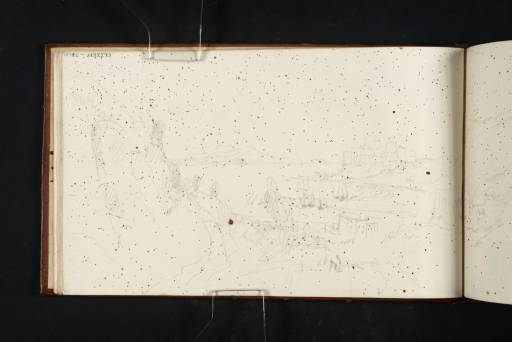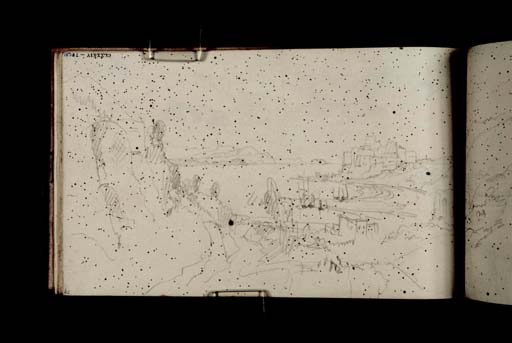Joseph Mallord William Turner The Bay of Baiae, with the Castle and the So-Called Temple of Venus 1819
Image 1 of 2
Joseph Mallord William Turner,
The Bay of Baiae, with the Castle and the So-Called Temple of Venus
1819
Joseph Mallord William Turner 1775–1851
Folio 81 Recto:
The Bay of Baiae, with the Castle and the So-Called Temple of Venus 1819
D15715
Turner Bequest CLXXXIV 79
Turner Bequest CLXXXIV 79
Pencil on white wove paper, 122 x 197 mm
Inscribed by ?John Ruskin in blue ink ‘281’ top left, inverted and ‘79’ bottom left, inverted
Stamped in black ‘CLXXXIV 79’ top left, inverted
Stamped in black ‘CLXXXIV 79’ top left, inverted
Accepted by the nation as part of the Turner Bequest 1856
References
1909
A.J. Finberg, A Complete Inventory of the Drawings of the Turner Bequest, London 1909, vol.I, p.545, as ‘Sketches of the Bay of Baiæ’.
1969
John Gage, Colour in Turner: Poetry and Truth, London 1969, p.131 [incorrectly as CLXXIV].
1984
Cecilia Powell, ‘Turner on Classic Ground: His Visits to Central and Southern Italy and Related Paintings and Drawings’, unpublished Ph.D thesis, Courtauld Institute of Art, University of London 1984, pp.180 note 42, 188 note 84, 247 note 85, 492 note 42.
1987
Cecilia Powell, Turner in the South: Rome, Naples, Florence, New Haven and London 1987, pp.79 note 35, 83 note 65, 120 note 47.
1998
James Hamilton, Turner and the Scientists, exhibition catalogue, Tate Gallery, London 1998, p.135 note 28.
This sketch depicts a view of the Bay of Baiae, an ancient Roman bathing resort approximately ten miles west of Naples. Turner’s viewpoint appears to be standing near the so-called Temple of Mercury looking south-east towards the Castello di Baia (Castle of Baiae), a former Aragonese fortress built to defend the Gulf of Pozzuoli. The castle was rebuilt during the sixteenth century after the eruption of nearby Monte Nuovo. Visible along the distant horizon is the coastline of Posillipo and the island of Nisida, whilst in the foreground on the right is an octagonal ruined bath-house, known as the Temple of Venus. The composition spills over onto the opposite sheet of the double-page spread, see folio 80 verso (D15714; Turner Bequest CLXXXIV 79). The details of the drawing are somewhat obscured by the dark spots covering the page. A number of scholars have followed John Gage’s suggestion that these were made by a shower of hot volcanic ash, probably dating from Turner’s ascent of Vesuvius, see folio 46 verso (D15645; Turner Bequest CLXXXIV 44a).1 More recently, however, James Hamilton has argued the marks were made by a spattering of a ‘light inky paint’.2
Turner made a large number of sketches of Baiae and its ancient monuments, see folios 79 verso–80 verso, 82, 84 verso–89 verso, 92 (D15712–D15714, D15717, D15722–D15732 and D15737; Turner Bequest CLXXXIV 77a–78a, 80, 82a–87a and 90). These studies formed the compositional basis of one of three oil paintings completed in the months and years following Turner’s return from his first tour of Italy, The Bay of Baiae, with Apollo and the Sibyl exhibited 1823 (Tate, N00505).3 Indeed the finished picture features a vista very similar to that depicted here and repeated within other on-the-spot drawings, and it is therefore possible that the artist was already planning the composition during his visit to the area.4
Nicola Moorby
June 2010
How to cite
Nicola Moorby, ‘The Bay of Baiae, with the Castle and the So-Called Temple of Venus 1819 by Joseph Mallord William Turner’, catalogue entry, June 2010, in David Blayney Brown (ed.), J.M.W. Turner: Sketchbooks, Drawings and Watercolours, Tate Research Publication, December 2012, https://www


